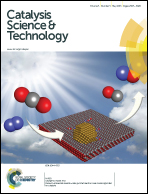Insights into the role of a structural promoter (Ba) in three-way catalyst Pd/CeO2–ZrO2 using in situ DRIFTS†
Abstract
A series of Pd/CeO2–ZrO2 (Pd/CZ) catalysts modified with barium oxide with different contents were prepared and characterized by XRD, BET, XPS, H2-TPR and NOx adsorption/desorption-MS. In particular, the effect of a structural promoter (Ba) on the catalytic and surface behaviour was investigated by means of in situ DRIFTS. Doped Ba enters into the CeO2 lattice, and thus results in the formation of more homogenous Ce–Zr–Ba ternary solid solution, which enhances the textural/structural thermostability and NOx storage efficiency of the catalysts. DRIFTS results indicate that the introduction of Ba weakens the strong adsorption of HC reactants on the surface of the catalysts. Furthermore, the addition of Ba accelerates the dissociation of NO and facilitates the formation of intermediates (NCO and CN) due to the outstanding electron-donating ability of Ba. Therefore, the Ba modified catalysts present much higher catalytic activity for HC and NOx conversions compared with Pd/CZ. However, the addition of Ba inhibits the oxidation of CO at low temperatures resulting from the decreased amount of active sites. In addition, the NOx operation window is widened with increasing Ba content due to the enhanced NOx storage capacity.


 Please wait while we load your content...
Please wait while we load your content...